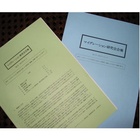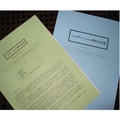1. Introduction: International students from East and Southeast Asia
In the 1930s, Japan was aiming to make a leap forward internationally, but at the same time, there was concern about isolation from the international community, especially after Japan's withdrawal from the League of Nations. As a response, the government was exploring a policy to actively accept students from neighboring countries. This included not only "foreign territories" such as Taiwan, Korea, and Manchuria, which were in Japan's sphere of influence, but also from areas outside of Japan's influence in Southeast Asia.
According to the Survey of the Status of Korean Students in Japan (1920) by the Educational Affairs Bureau of the Government-General of Korea, the Survey of Korean Students in Japan (1926) by the Korean Education Scholarship Department, and the Status of Social Movements (1936 and 1941) compiled by the Police Bureau of the Ministry of Home Affairs, the number of Korean students studying in Japan fluctuated at just under 5,000 in the 1920s. Later, in the 1930s, the policy of Imperialization encouraged studying abroad, and by 1939 (Showa 14), the number of Korean students had exceeded 15,000. The following year, about 20,000 students crossed the Genkai Sea, and by 1942 (Showa 17), about 30,000 students crossed the Genkai Sea. As a result, the proportion of women among the students, which had previously been mostly male, also increased. Previous research has explained the movement of Korean students in Japan from the perspective of the relationship between religions such as Christianity and Buddhism and academic systems in the international context of Japan at that time.
On the other hand, let's take a look at students from Southeast Asia, especially the Philippines. At the time, the Philippines was a colony of the United States, and many students from the Philippines studied at medical schools with the aim of acquiring specialized skills. In particular, in the early 1930s, the Jikei University of Medicine in Tokyo was well-known as a place to accept students. This was due to the fact that the university was practically the only one in Japan that could provide medical education in English, and that the Immigration Act of 1924 made it difficult to study in the United States.
2. Selected university and major
Looking at the trends in the majors of Korean students studying in the "mainland" of Japan, it varies by year. In the early 1920s, most came to study law. In the latter half of the 1920s, the proportion of students studying science and engineering increased, and this trend was particularly noticeable among men. In contrast, it was common for women to study at normal schools with the aim of becoming teachers in primary and secondary education. Looking at universities in Tokyo at the time with five or more Korean students, most at Meiji University and Nihon University majored in law. Although there are issues with the name and organization, the majority of Koreans at Waseda University studied political science and economics. Thus, although the number of surveys is limited, differences can be seen in the academic subjects chosen by the university.
In 1933 (Showa 8), the number of Korean students studying abroad varied significantly depending on the province they came from. In other words, there were many students from the southeastern part of the Korean peninsula close to Japan, such as Gyeongsangnam-do, represented by Busan, as well as North Gyeongsang-do and South Jeolla-do. There were also a certain number of students from Gyeonggi-do, which includes the capital, Keijo (present-day Seoul). At the time, it seems that students aimed for Tokyo, the capital of Japan, to acquire the latest and greatest academic knowledge in Asia.
Many of the international students at Waseda University are from Gyeonggi-do, which is roughly similar to the trend seen in Korea as a whole mentioned above. Ritsumeikan University, which was founded in Kyoto, also shows a similar trend, although the absolute numbers are small. In other words, there are many international students from the southeastern part of the Korean Peninsula, which is close to Japan, and the area around Gyeongseong. In contrast, Kansai University in Osaka City has a large number of international students from Jeollanam-do. This can be considered to indicate the strong ties between Osaka and Busan or Jeju Island.
3. International students at Ritsumeikan University
According to the "Survey on Koreans Living in the City" published by the Kyoto City Social Affairs Division in 1937 (Showa 12), the number of Koreans travelling to Kyoto began to increase in the late 1920s. Until then, only around 100 people had been seen travelling each year, but by 1927 (Showa 2), the number had exceeded 800, and thereafter just under 1,000 Koreans came to Kyoto. Most of the reasons for travelling were primarily for livelihood reasons, such as "making money," "seeking work," or "due to financial difficulties in Korea." In contrast, there were very few people who travelled for the purpose of "studying."
In Kyoto City in 1912 (Meiji 45, Taisho 1), the residences of Korean students were scattered in specific areas. The six students whose addresses could be confirmed seem to have lived near the junior high schools and universities of Doshisha, Higashiyama, Heian and Ryukoku, or in their dormitories. As these schools were founded on Christianity or Buddhism, it can be said that the main reason Koreans came to Kyoto to study in the early modern period was religious. In the case of Ritsumeikan University, which does not have a specific religious roots, it becomes interesting to consider the relationship between the reasons Koreans came to study abroad and employment after graduation.
According to the "All Ritsumeikan Student Association Directory" compiled and published by Ritsumeikan University in 1943 (Showa 18), there were about five Korean students graduating from Ritsumeikan University every year in the 1930s. Although the number decreased for a time, it eventually increased, and in 1941 (Showa 16), about 130 students graduated. Looking at Korean students graduating from 1938 (Showa 13) to 1940 (Showa 15) by major, although there was a difference between specialist faculties and regular courses, most studied in the law department of the law faculty. The actual number was around three to five students, but the proportion of each major was 10% of the total, and there were some majors and years in which they accounted for nearly 20%.
Additionally, the transcript of a roundtable discussion published in the Ritsumeikan University Uri Alumni Association magazine Genkai-Nada Vol. 4, 1982, includes recollections of a Korean student who was enrolled before the war (bold text added by the author).
"There were two or three in each faculty. At night schools, there were apparently a few more. At each specialized faculty, there were about ten.... The general psychology of students at that time was that they couldn't shake the idea that they were an oppressed people. You couldn't go to school without money, so it was extremely rare to become a student anyway. After graduating from Daegu Commercial School, I worked for a financial institution for around five years ."
He also left the following words:
"I think that at the time, there was a strong sense of mission for students studying at the highest educational institutes. The idea was that they were studying in order to win independence for their country and to use their knowledge for the sake of their people."
From these recollections, it appears that Korean students at Ritsumeikan University did not necessarily "study abroad" at universities in Japan (mainland) during or after their time at secondary or high school or university in Korea. They seem to have "studied" at Ritsumeikan University in order to study more advanced academic subjects after getting a job, in other words, to step up in society. Also, one cannot help but sense a noble sense of national mission in their words. This tendency seems somewhat different from the cases of Korean students at Waseda University, who went directly to Japanese universities after graduating from Korea, and at Kansai University, which studied in the commercial city of Osaka.
© 2011 Norifumi Kawahara









